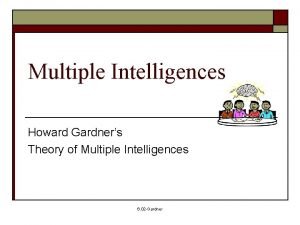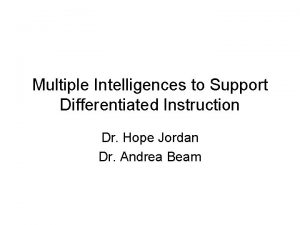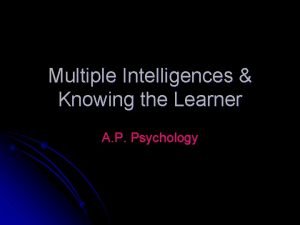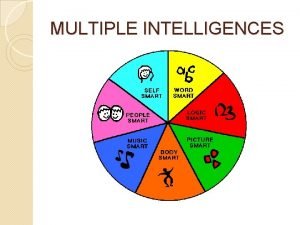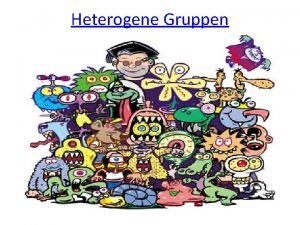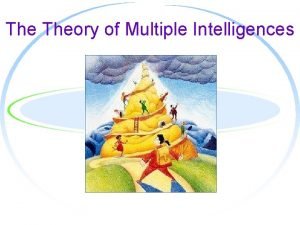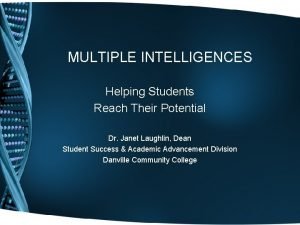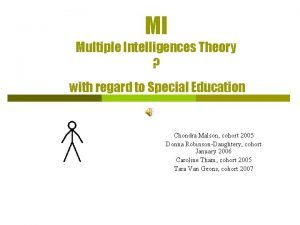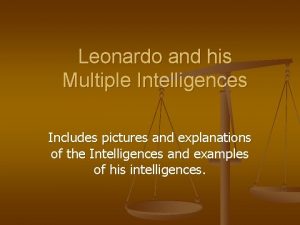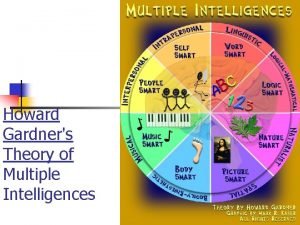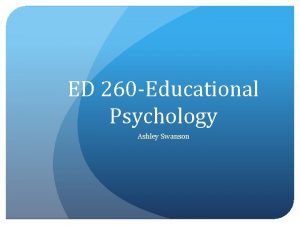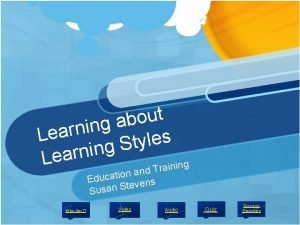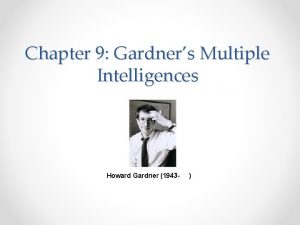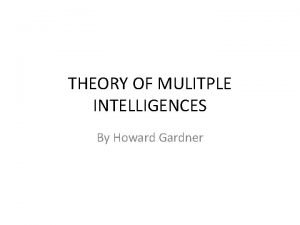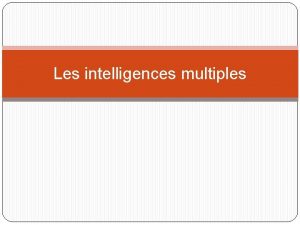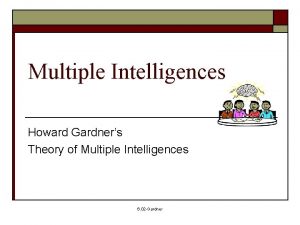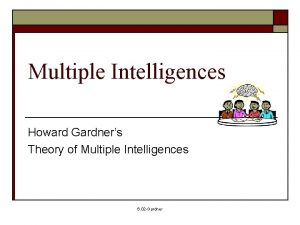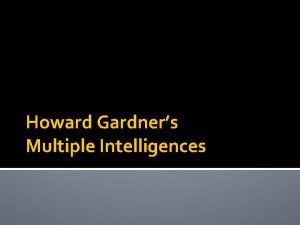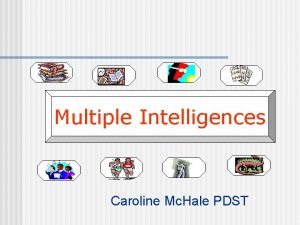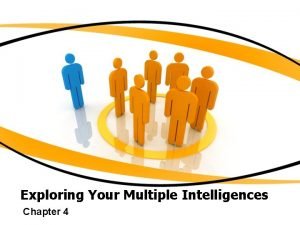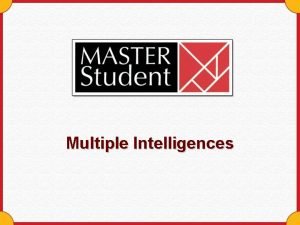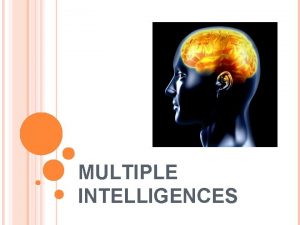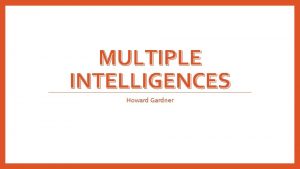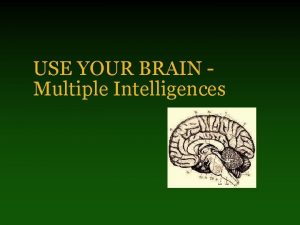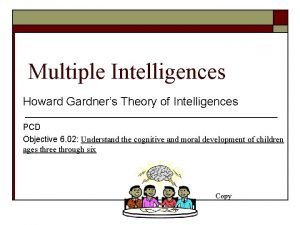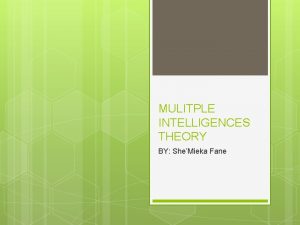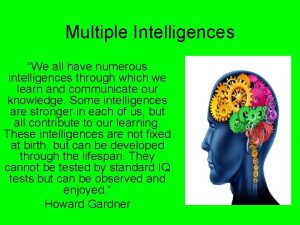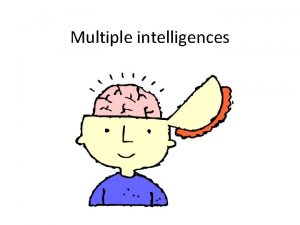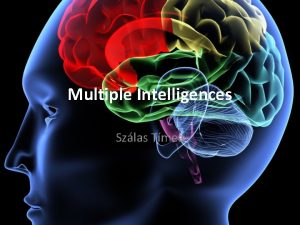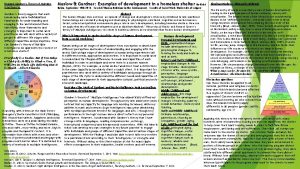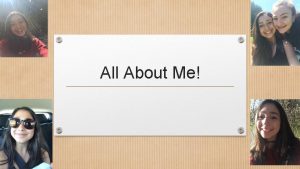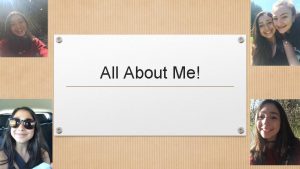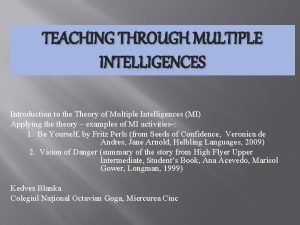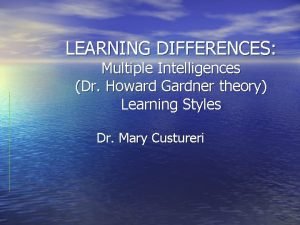MULTIPLE INTELLIGENCES The theory of multiple intelligences was



























- Slides: 27

MULTIPLE INTELLIGENCES “The theory of multiple intelligences was developed in 1983 by Dr. Howard Gardner, professor of education at Harvard University. It suggests that the traditional notion of intelligence, based on I. Q. testing, is far too limited. Instead, Dr. Gardner proposes eight different intelligences to account for a broader range of human potential in children and adults. ” Thomas Armstrong - www. Thomas. Armstrong. com Dr. Gardner

The Multiple Intelligences are: • Verbal/Linguistic Intelligence - “word smart” • Logical-mathematical Intelligence - “number/reasoning smart” • Visual/Spatial Intelligence - “picture smart” • Bodily/Kinesthetic Intelligence - “body smart” • Musical/Rhythmic Intelligence - “music smart” • Interpersonal Intelligence - “people smart” • Intrapersonal Intelligence - “self smart” • Naturalist Intelligence - “nature smart”

Multiple Intelligences examples: • Verbal/Linguistic Intelligence • Mark Twain, Robert Frost, poets, writers, newscasters • Logical-mathematical Intelligence • Einstein, accounting, banking, medicine, scientific research • Visual/Spatial Intelligence • Martin Luther King (dreamer). artists, architecture, advertising • Bodily/Kinesthetic Intelligence • Adrian Peterson , dancers, dramatic acting, mime, physical education • Musical/Rhythmic Intelligence • Taylor Swift, music composers, music teachers, musical theatre • Interpersonal Intelligence • Billy Graham, counseling, politics, sociologists, therapists • Intrapersonal Intelligence • Psychiatry, spiritual counseling, philosopher • Naturalist Intelligence • Farmers, gardeners, florists, geologist, archaeologists

Multiple Intelligences “Dr. Gardner says that our schools and culture focus most of their attention on linguistic and logical-mathematical intelligence. We esteem the highly articulate or logical people of our culture. However, Dr. Gardner says that we should also place equal attention on individuals who show gifts in the other intelligences. Unfortunately, many children who have these gifts don’t receive much reinforcement for them in school. Many of these kids, in fact, end up being labeled ‘learning disabled, ’ ‘ADD’ (attention deficit disorder), or simply underachievers, when their unique ways of thinking and learning aren’t addressed by a heavily linguistic or logical mathematical classroom. ” Thomas Armstrong - www. Thomas. Armstrong. com Gifted and Talented Students handout

Multiple Intelligences Theory The theory of multiple intelligences proposes a major transformation in the way our schools are run. It suggests that teachers be trained to present their lessons in a wide variety of ways using music, cooperative learning, art activities, role play, multimedia, field trips, inner reflection, and much more.

How to Teach or Learn in 8 Different Ways “One of the most remarkable features of theory of multiple intelligences is how it provides eight different potential pathways to learning. If a teacher is having difficulty reaching a student in the more traditional linguistic or logical ways of instruction, theory of multiple intelligences suggests several other ways in which the material might be presented to facilitate effective learning. Thomas Armstrong - www. Thomas. Armstrong. com

8 Different Ways Whatever you are teaching or learning, see how you might connect it with: Words Numbers, or logic Pictures Music Self-reflection A physical experience A social experience An experience in the natural world verbal/linguistic logical/mathematical visual/spatial musical/rhythmic intrapersonal bodily-kinesthetic interpersonal naturalist

Teaching Example For example, if you’re teaching or learning about the law of supply and demand, you might : • Read about it (linguistic) • Study mathematical formulas that express it (logical/mathematical) • Examine a graphic chart that illustrates the principle (spatial) • Observe the law in the natural world (naturalist) • Observe the law in the human world of commerce (interpersonal) • Examine the law in terms of your own body, e. g. when you supply your body with lots of food, the hunger demands goes down; when there’s very little supply, your stomach’s demand for food goes way up and you get hungry (bodily-kinesthetic/intrapersonal) • Write a song that demonstrates the law (musical)

Multiple Intelligences Concept to Classroom http: //www. thirteen. org/edonline/concept 2 class/mi/index. html MI WHEEL ACTIVITY Multiple Intelligences and Technology http: //www. casacanada. com/multech. html

Multiple Intelligences Report Card 1, Write the name of a book you have read lately. 2. Rate your math ability from 1 -10 with 10 being highest. 3. Write down the name of the kind of music you like. 4. Write down how you revitalize yourself. 5. Write down what you can do that is a physical activity. 6. Draw a picture that shows how you are feeling today.

Self-Analysis Worksheets Multiple Intelligence Assessment Complete and bring results to next class

Multiple Intelligences Rap by Shawna Munson The eight intelligences are really cool. We all have them so no one is a fool Naturalists are collectors of animals and plants. They like to press flowers and count little ants. Linguistic deals with writing and with words. We have language - we're not like animals or birds. All of these so far are really neat, But I like musical 'cause it has a beat. Logical-mathematical doesn't need to be a shock. Sometimes, I feel lonely, without any friends, If you study real hard, you'll be smarter than Spock! But interpersonal skills put that to an end. Spatial involves seeing, drawing, and art, Creating different things and taking them apart. Intrapersonal skills are when you want to reflect. For yourself, you should always have respect. In case you didn't know, kinesthetic is P. E. Get fit and coordinated athletically! Now, I've come to the end of my rap. Learn in many ways and you'll never be a sap.

MI in the Classroom activities frequently activate and utilize more than one of the multiple intelligences. * * * Group discussion - Verbal-Linguistic; Interpersonal * Journal writing - Intrapersonal; Verbal/Linguistic * Choreography - Musical-Rhythmic; Verbal-Linguistic; Interpersonal * Constructing timelines - Logical-Mathematical; Visual-Spatial Putting on a play - Musical-Rhythmic; Verbal/Linguistic; Interpersonal; Visual-Spatial Making a video - Logical-Mathematical, Musical-Rhythmic; Verbal/Linguistic; Interpersonal; Visual-Spatial * Writing a report or essay - Verbal-Linguistic * Making graphs - Logical-Mathematical; Visual-Spatial * Designing posters - Verbal-Linguistic, Visual-Spatial Communicating with peers or experts online - Verbal-Linguistic; Interpersonal * Hands-on experimentation - Kinesthetic; Logical/Mathematical * Composing a song - Musical/Rhythmic; Verbal-Linguistic * Building a model or 3 -D displays - Kinesthetic; Logical-Mathematical http: //www. thirteen. org/edonline/concept 2 class/mi/exploration_sub 1. html

Children’s Literature book – Multiple Intelligences Activities

SAMPLE MI LESSONS Primary School Web Sample - handout Caps for Sale by Esphyr Slobodkina Video

Caps For Sale Verbal/Linguistic 1. Read the story to the whole class 2. Ask students to respond to the story and write about it. 3. Write a magical cap story. 4. Write important parts of the story in a sequence and illustrate. Musical/Rhythmic 1. Write a catchy jingle or rap to sell caps 2. Sing a song about the story. 3. March in a cap parade singing the song

Caps for Sale Logical/Mathematical 1. Have a collection of caps and brainstorm many ways to sort them. 2. Graph distances from students’ homes. 3. Make up word problems involving cap-purchasing stories at fifty cents per cap. Visual/Spatial 1. Have students close their eyes and think of the story, Caps for Sale, . Ask them to capture their favorite part by drawing and writing about it. 2. Ask students to design a new style cap and logo.

Caps for Sale Bodily/Kinesthetic 1. Bake money-shaped cookies. 2. Role play the story. 3. Have a cap parade. 4. Have a cap relay Intrapersonal 1. Have the students write down all they know about monkeys. Interpersonal 1. In literacy study groups discuss the plot, setting, character, problem, and solution for the Caps for Sale story.

Shapes - Circles • Make a group circle by joining hands. Interpersonal, Bodily-Kinesthetic • Look for circles around the classroom. Spatial • Make circles in art projects. Spatial, Bodily-Kinesthetic • Sing “The Circle Game” and other circle songs. Musical • Make up stories about circles. Linguistic • Compare sizes of circles (from small to large). Spatial, Logical-Mathematical

Multiplication - 7’s table • Count to 70, standing up and clapping on every seventh number. Bodily-Kinesthetic • Sing the Multiplication Rock song for the 7’s. Musical • Chant the numbers 1 to 70, placing special emphasis on every seventh number. Musical • Complete a “hundreds chart, ” coloring in every seventh number. Spatial

Multiple Intelligences Spelling • Create categories for your spelling words. logical-mathematical • Write your words using different colors for the letters of parts of the word. visual/spatial • Make up a story using all spelling words. Tell the story to another person. verbal/linguistic • Sing-spell your words to the melody of your favorite song. musical • Create your own goals on how you will study and learn your spelling words. intrapersonal

Multiple Intelligences Poster • Verbal/Linguistic Intelligence • Logical-mathematical Intelligence • Visual/Spatial Intelligence • Bodily/Kinesthetic Intelligence • Musical/Rhythmic Intelligence • Interpersonal Intelligence • Intrapersonal Intelligence • Naturalist Intelligence -


Multiple Intelligences Assessment Lesson Assessment http: //www. gigglepotz. com/miassess. htm

Multiple Intelligences Instructional Techniques and Ideas http: //www. educ. state. ak. us/tls/frameworks/sstudies/part 3 a 2. htm 8 Kinds of Smart handout

Multiple Intelligences Video

Multiple Intelligences Assessment “How can you use theory of multiple intelligences to assess student achievement in your classroom? The MI approach to testing is closely related to authentic assessment. This approach enables students to demonstrate the depth of their understanding, connect their classwork to real-life experiences, and apply their knowledge to new situations. ” Using Multiple Intelligences in Assessment http: //www. teachervision. fen. com/lesson-plans/lesson-4933. html? detoured=1 “There is no "right" way to use multiple intelligences in testing and assessment. You don't have to overhaul your whole curriculum. But you can make an effort to address each student's strengths and weaknesses by using creative alternatives to traditional testing in your classroom. ”
 Howard gardners theory of multiple intelligences
Howard gardners theory of multiple intelligences Multiple intelligences and differentiated instruction
Multiple intelligences and differentiated instruction Bodily kinesthetic intelligence
Bodily kinesthetic intelligence Bgfl multiple intelligence
Bgfl multiple intelligence Extracurricular activities
Extracurricular activities Montessori for multiple intelligences
Montessori for multiple intelligences Gardner's multiple intelligences
Gardner's multiple intelligences Interpersonal intelligens
Interpersonal intelligens Multiple intelligences in the classroom
Multiple intelligences in the classroom Multiple intelligences
Multiple intelligences Leonardo da vinci multiple intelligences
Leonardo da vinci multiple intelligences Multiple intelligences test
Multiple intelligences test Multiple intelligences test
Multiple intelligences test Gardner musical intelligence
Gardner musical intelligence Multiple intelligences and learning styles
Multiple intelligences and learning styles Edutopia multiple intelligences quiz
Edutopia multiple intelligences quiz Gardner's nine intelligences
Gardner's nine intelligences Mulitple intelligence
Mulitple intelligence Intelligences multiples
Intelligences multiples Hình ảnh bộ gõ cơ thể búng tay
Hình ảnh bộ gõ cơ thể búng tay Slidetodoc
Slidetodoc Bổ thể
Bổ thể Tỉ lệ cơ thể trẻ em
Tỉ lệ cơ thể trẻ em Voi kéo gỗ như thế nào
Voi kéo gỗ như thế nào Glasgow thang điểm
Glasgow thang điểm Hát lên người ơi alleluia
Hát lên người ơi alleluia Môn thể thao bắt đầu bằng từ chạy
Môn thể thao bắt đầu bằng từ chạy Thế nào là hệ số cao nhất
Thế nào là hệ số cao nhất
